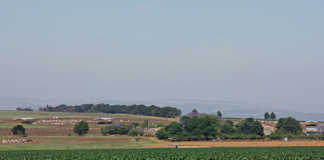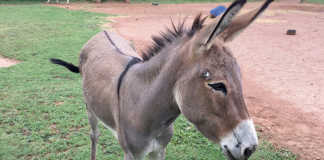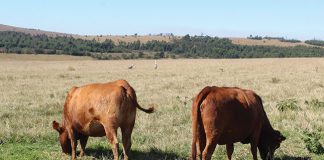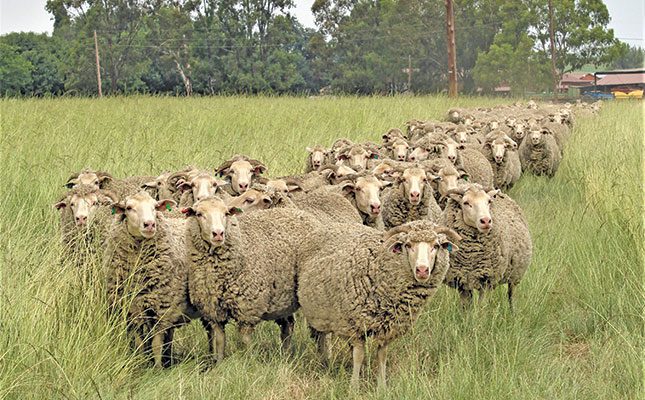
Photo: Lindi Botha
Mpumalanga’s Bethal region is known for its diversified farming operations, where producers use the crop residue from maize and soya bean harvests to feed their livestock.
While cattle production occurs throughout the area, sheep farming is almost completely absent.
That is, until you get to Joubertsvlei Boerdery Trust, where owner Johan Steyn runs a flock of 5 000 Merino sheep. Moreover, he aims to grow this number.
“Managing [stock] theft costs money, but security costs the same whether you employ a guard to watch 1 000 or 5 000 sheep. So, the more I expand my flock, the less I pay per sheep for security, and the higher my income,” says Steyn.
He adds that stock theft is by far the biggest barrier to farming sheep on the Highveld. However, as he appears to have this under control, there is much scope for improving his business’s bottom line.
Sheep production has a faster turnover than cattle production, thereby ensuring a steady cash flow, and the fact that the Merino is a dual-purpose sheep means that an additional income can be earned from the wool.
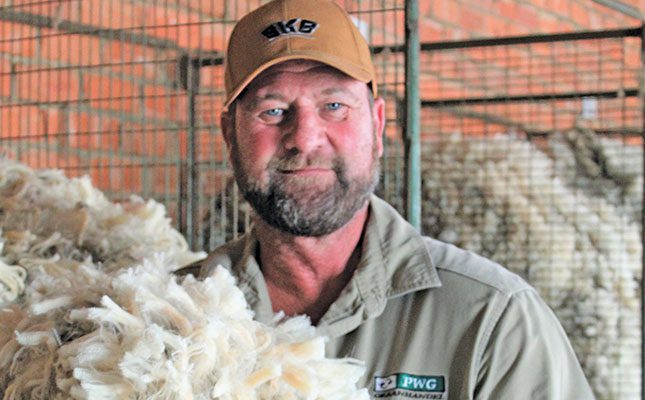
Moreover, sheep utilise maize and soya bean residue better than cattle do, so they don’t require additional feed in winter.
Sheep have long been a part of Joubertsvlei Boerdery Trust, having been introduced to the operation by Steyn’s father, Naas, in 1965. Father and son farmed together for 27 years before Naas retired in 2014 and Steyn took over the reins.
Steyn explains that during his father’s time on the farm, the Merinos were bred to have less wrinkly skin, ensuring they had a more streamlined shape. While having more wrinkles produces a higher wool yield (due to greater surface area), this ends up reducing the overall size of the sheep, which is counterproductive for meat production.
Today, his Merinos can stand up to the Dohne Merino breed, a truly dual-purpose sheep that provides ample wool and meat.
Feed quality and wool strength
A big factor in the success of Steyn’s flock is that he follows an extensive sheep-farming system. “I don’t want sheep that need to be pampered. I chase my Merinos onto the veld, dose them correctly against parasites, and then they take care of themselves,” he says.
The sheep live off red grass (Themeda triandra) veld between October and April, at a stocking rate of 0,33ha/SSU, and feed on crop residue in winter. The production of strong, high-quality wool relies on feed of a consistent standard.
“It’s not only sick sheep that produce wool that breaks easily; the problem is very common when sheep suddenly switch between feeds of different quality. “The price paid for this wool is obviously lower, as one of the parameters by which wool is judged is the strength of the fibres. Ensuring there are no weak spots in the fibres is crucial for obtaining good prices,” explains Steyn.
To prevent his sheep from producing wool with weak spots, he gives them grain feed during the last two weeks of April, when the nutritional quality of the grass has started to decline.
In this way, by the time they are placed on the croplands, they are already conditioned to the higher-quality feed, so the strength of their wool remains stable.
Between August and October, when crop residue has been eaten but the veld has yet to be replenished by rainfall, the sheep are given bales of hay made from Eragrostis harvested from land around the crops. They also receive oats and a production lick. The latter is especially important, as both mating and lambing season occur in spring, so the sheep need to be in good condition at this time.
Two breeding seasons
Steyn has two five-week mating seasons for his 2 500 ewes, at a ratio of 50 ewes to a ram.
Approximately 2 000 ewes are placed with rams on 10 October, which means they start lambing in March. The remaining 500 are put with the rams on 10 May, and their lambing season starts in mid-October.
The two lambing seasons improve the farm’s cash flow and also give ewes that did not wean lambs the first time around a second chance.
“The aim of mating ewes in May is to supplement those that lambed in March, but didn’t wean their lambs. I also sell ewes that don’t conceive, so the overall fertility [rate] of the herd isn’t negatively influenced,” says Steyn.
“There are also those ewes that lambed but didn’t wean their young because the lambs were sick, died from the cold, or were taken by jackal. These are circumstances beyond their control, so I don’t want to remove them from the flock, but rather give them another chance.”
After weaning, the ewe lambs are selected according to on-farm performance testing. The weaker lambs are sold, and the wethers are kept for three years in a separate camp. This is far away from the others, and Steyn says he doesn’t place the rest of the flock there as they would be annihilated by jackal.
“I want to make the most of all of my land, so I keep about 850 wethers in this separate camp and don’t need to give them additional feed. I get about three wool harvests from them before they’re sold as C-grade animals.”
Steyn achieves a conception rate of 94%, of which 25% are twins, a lambing rate of 92%, and a weaning rate of 82%. The inter-lambing period is 365 days. The biggest hurdles to increasing the weaning rate are parasites and predators, the latter being a particular threat to lambs.
Each year, Steyn markets around 20% of the flock for meat, and replaces 20% of the ewes with others from the flock that have reached the two-tooth stage.
Flock health
The Highveld climate creates a breeding ground for pests, and farmers have to maintain a regular dosing and vaccination programme. Steyn’s flock is vaccinated against enzootic abortion and Rift Valley fever. Once they have been shorn, they are dipped to control ticks and then returned to the veld.
Wireworm is especially prevalent during periods of high rainfall, and keeping the sheep worm-free goes beyond extra dosing.
“For wireworm, I try to use a different active ingredient every time so the pest doesn’t build up resistance,” says Steyn. “I also try to use the latest medicines with new active ingredients only once a year, so that I can prolong their efficacy in the flock.
“Unfortunately, there are no new active ingredients in the pipeline, so if we lose efficacy with the current medicines, we’ll be in big trouble.
“I need to inoculate the six-month-old rams against brucellosis with a vaccine called Rev-1. I’ve been searching for this vaccine since September 2022 without success. It simply isn’t available, and Onderstepoort [Biological Products] can’t provide it.
“There are private companies that can and will produce it, but government won’t allow them to. The [shortage] of vaccines is a major problem that can be solved, but government needs to want to solve it. As farmers, we can make all kinds of plans to survive, but some things are beyond our control.”
The overall hardiness of the animals is vital, and this highlights the need for selecting animals with the right genetic make-up.
Adapted animals
For Steyn, having rams that are adapted to the veld, and specifically the Highveld with its unique challenges, is one of the keys to successful sheep farming. This is one reason he is a member of the Highveld Merino Veld Ram Club, a group of 10 breeders who farm in the same area and breed animals that thrive in this environment.
“Obtaining sheep from the Karoo, for example, wouldn’t work, because they’re raised in an environment where the pest and disease load is far lower [than it is in our region], so their resistance is [lower],” he explains.
All the club members put their rams through performance testing, where they are kept together and treated equally. After the test period, the sheep are shorn and the rams graded. Those with an above-average performance are sold at the club’s biannual auction.
This is also where Steyn buys rams if he wants to bring new genetics into his flock. He also breeds his own rams, selecting about 150 ram lambs from his flock. The best 15 go on to be performance-tested and sold through the club. Another 120 are put through on-farm performance testing, and their wool is tested after shearing. Of these, Steyn keeps the top-performing rams for breeding and sells the rest.
Achieving balance
Steyn believes in achieving a desirable middle ground between wool and meat production. He therefore aims for a good quantity of wool without pursuing overly fine fibre.
“My wool averages around 18,5 microns, which is just right for me. With sheep, many of the characteristics have negative correlations. Finer wool achieves higher prices, but if I breed for finer wool, then the [meat] yield tends to dip, so I end up with smaller-framed animals that produce less meat.
“Big animals and strong wool usually go hand in hand, while finer wool is obtained from smaller animals. I try to achieve a balance.”
Steyn’s sheep are shorn every 12 months to ensure that the wool achieves a length grading of at least a C. Many farmers choose to shear every six months, but this means that the wool has not had much time to grow to a good length.
The longer A, B and C categories are the most desired on European markets, while the Chinese market prefers fibres of a shorter length.
Shearing takes place in January, a quieter period on the farm, as the planting season has been wrapped up by then, and much of the summer rainfall has dissipated. Steyn shears with a winter comb, as he prefers to leave the sheep with a little extra insulation in case the area is hit by a cold front.
His average wool yield is 4kg per sheep, with some animals providing as much as 7kg each. As the market is subject to fluctuations, Steyn keeps his wool back until he can get the best possible price.
Point of profitability
While lamb and mutton retail prices have risen substantially over the years, Steyn says farmers haven’t benefitted a great deal. “There’s a big gap between what farmers
receive [for their meat] and what the supermarkets charge. All prices go up with inflation, but they should be in line with each other. Instead, the gap is widening between what I get for my product and what I have to pay when I need to buy something.
“In my father’s day, he had to sell 100 wethers to be able to afford a new Land Cruiser bakkie. Now, I have to sell 500 to afford the same vehicle.”
Making a success of sheep farming is therefore dependent on minimising input costs and maximising output. This means keeping stock theft to a minimum, managing pests properly, and ensuring that the animals are well cared for without having to spend too much on licks.
For Steyn, the combination of natural veld and crop residue means that sheep have their place within his business.
“Sheep production complements crop farming, so much so that it’s very cost-effective to keep these animals. I believe there’s still a lot of potential to farm sheep on the Highveld, if stock theft can be managed,” he adds.
Email Johan Steyn at [email protected].








